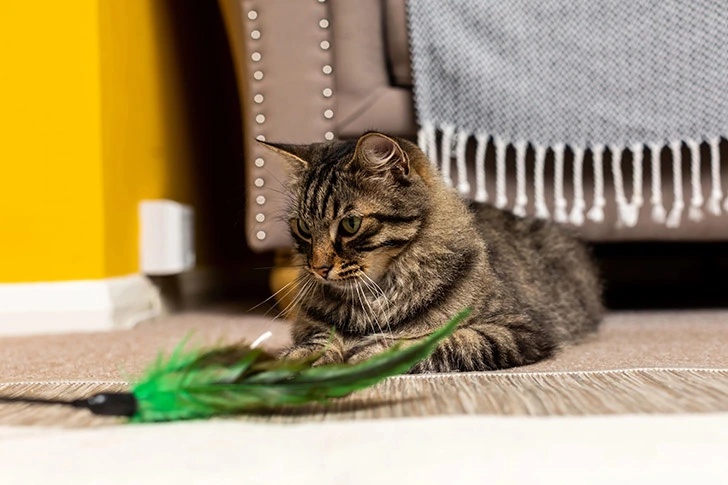Playing with your cat is a great way to bond and have fun in the process. It's also important for their wellbeing and health as well as being key to a kitten's development.
Cats that can freely go outdoors will often engage in hunting activity or will play with fallen leaves or grass blowing in the wind if there is no access to prey. The drive to hunt is not because they are hungry, but because hunting activity – the stalk, pounce, play and kill – releases feel-good hormones called endorphins. It's important that your cat is given lots of opportunity to play to keep them mentally stimulated.
Play is very important for cats, particularly kittens, as it teaches them the skills needed for life and lessons about the world around them. Play is a great way for a cat to use up some of their energy, keep fit and healthy and keep their brain alert and active. The best games encourage cats to stalk, pounce, chase and bat objects with a paw in a safe way.
There are a wealth of benefits to providing play for your adult cats. Find out why play is important and how it is best to play with your cat in our video.


Older cats will love playing three or four times a day, while younger cats will be happy to play ten times a day or more.
Very short games of one to two minutes are fine. Swap toys around regularly to keep them interesting, but don’t leave your cat on their own with toys which could be shredded and eaten or ones that they can get tangled in. Check toys regularly for signs of wear, replacing them when needed.
Indoor cats need more entertainment than outdoor cats, so make dinner time more of a challenge by feeding cat biscuits through a puzzle feeder or a plastic drinks bottle, with biscuit sized holes cut into it. The cat will learn that batting the bottle releases a biscuit. It also means that he will take his time eating his food!
To to keep your cat occupied, give them some much-needed exercise or slow down their eating so they're not overeating, check out our video on how to make a feeding enrichment toy.
You can also find out more about how to make a food puzzle on our blog.
If your cat often tries to grab your ankle, goes for a scratch or bites you when wanting to play with them – those could be the signs of redirected play aggression. It is more common with kittens and young cats but can also be experienced with cats of any age.
Whether this kind of behaviour is a new thing or increases over time, it can also be a sign that your cat is under-stimulated which can often happen with indoor cats. When there is a lack of play or ‘prey’ opportunities, your cat might try to redirect it onto people.
If an adult cat suddenly starts showing signs of play aggression when they haven’t before, it would be good to call the vet and get them checked out for any medical concerns and then consult a qualified behaviourist.
Redirected play aggression can be a result of the way your cat has been used to interacting with you since they were a kitten. When it comes to playing with a kitten, using fingers and toes as part of a game might seem fun but the appeal can quickly wear off when they grow into adult cats and the same kind of play becomes more painful.
Playing with fingers or toes at any stage of a cat’s life, especially with kittens and younger cats, shouldn’t be encouraged. Once they learn that this is an appropriate way to play, they will continue to play like that. Find out more about why cats might bite.
To avoid hunting behaviour being misdirected onto you, we recommend using cat toys and games that are distant from your body such as ‘fishing rod’ toys or throwing a ball. As well as pouncing and catching toys, many cats will also enjoy expressing their “bunny kicking” behaviours. A larger, Kickeroo style toy can work really well.
Play sessions should be a regular part of your cat’s daily routine and they are especially important for indoor-only cats.
Learn more about the differences between cats fighting and playing in our advice guide.
